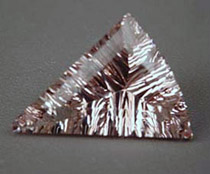


Morganite is beryl colored by manganese impurities. Although violet and peach are possible colors, the most common and preferred color is pink. Heat and light will remove the yellow component from peach beryl so it is often heated to get "pinker" stones. It entered the American market in 1911 when Tiffany & Co. introduced it and named it in honor of J.P. Morgan. Original deposits from Madagascar are now worked out, but Brazil, Namibia and other locations produce rough. Growth tubes are a typical inclusion in beryl and often seen in Morganite. Very often near colorless specimens are offered as Morganite when they more properly should be labeled Goshenite (colorless beryl). Although it takes a larger stone to develop really good body color, smaller stones can be very brilliant. Like most beryls, Morganite makes an excellent jewelry stone requiring no special care.



Medium light to medium pink, clean stones with custom cuts are the most valuable. Very light and included stones are on the lower end of the value spectrum. As Morganite frequently occurs in larger crystals, there is not the exponential increase in price with size we see in so many gems. Paradoxically, smaller Morganites (if they show good color) can be more valuable than larger ones which often, in order show good color must be so large as to limit their reasonable use in jewelry. As is the case with aquamarine, there is a small but growing segment of collectors who prefer the unheated peachy color and are willing to pay a premium to get an untreated piece.